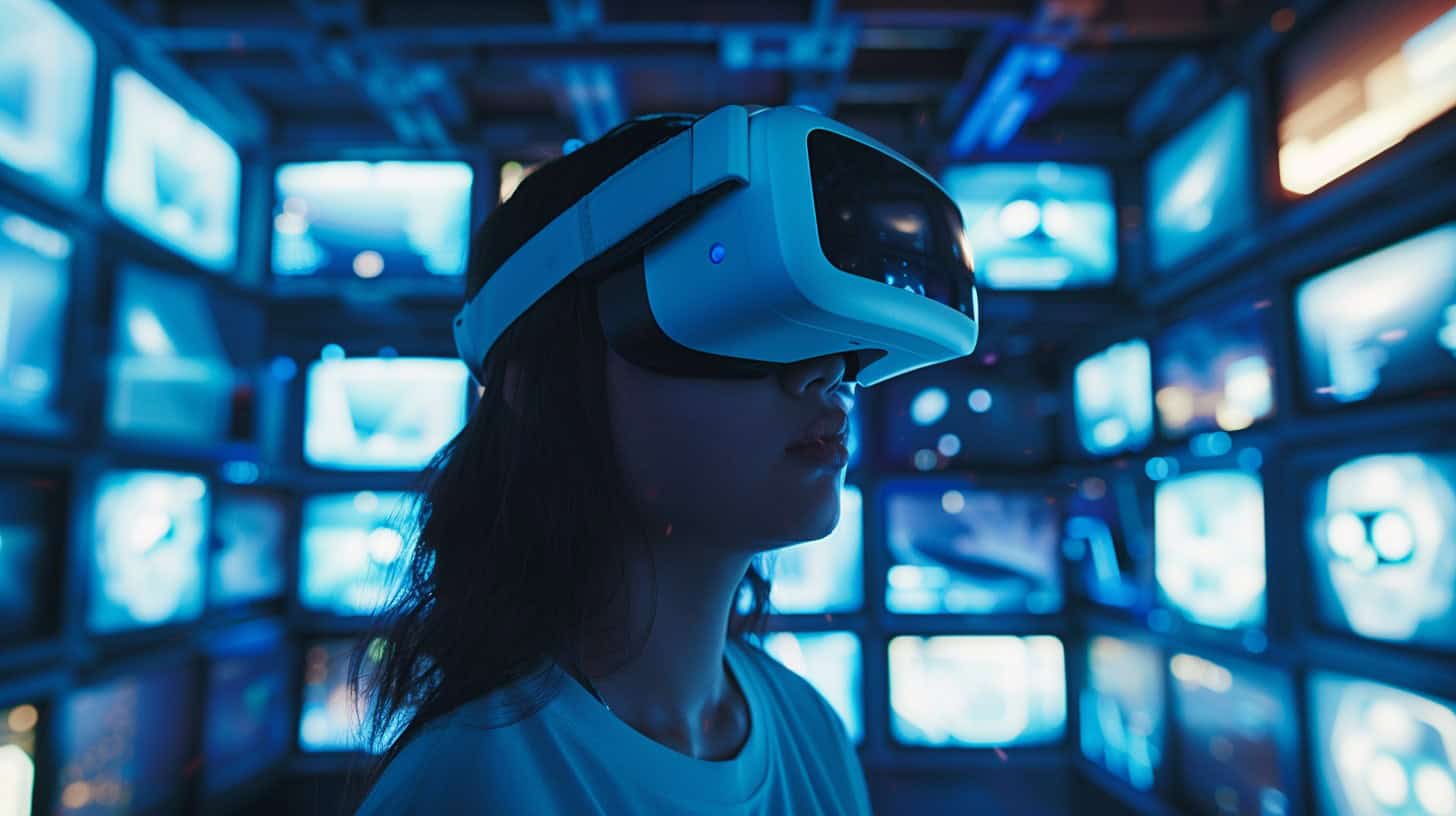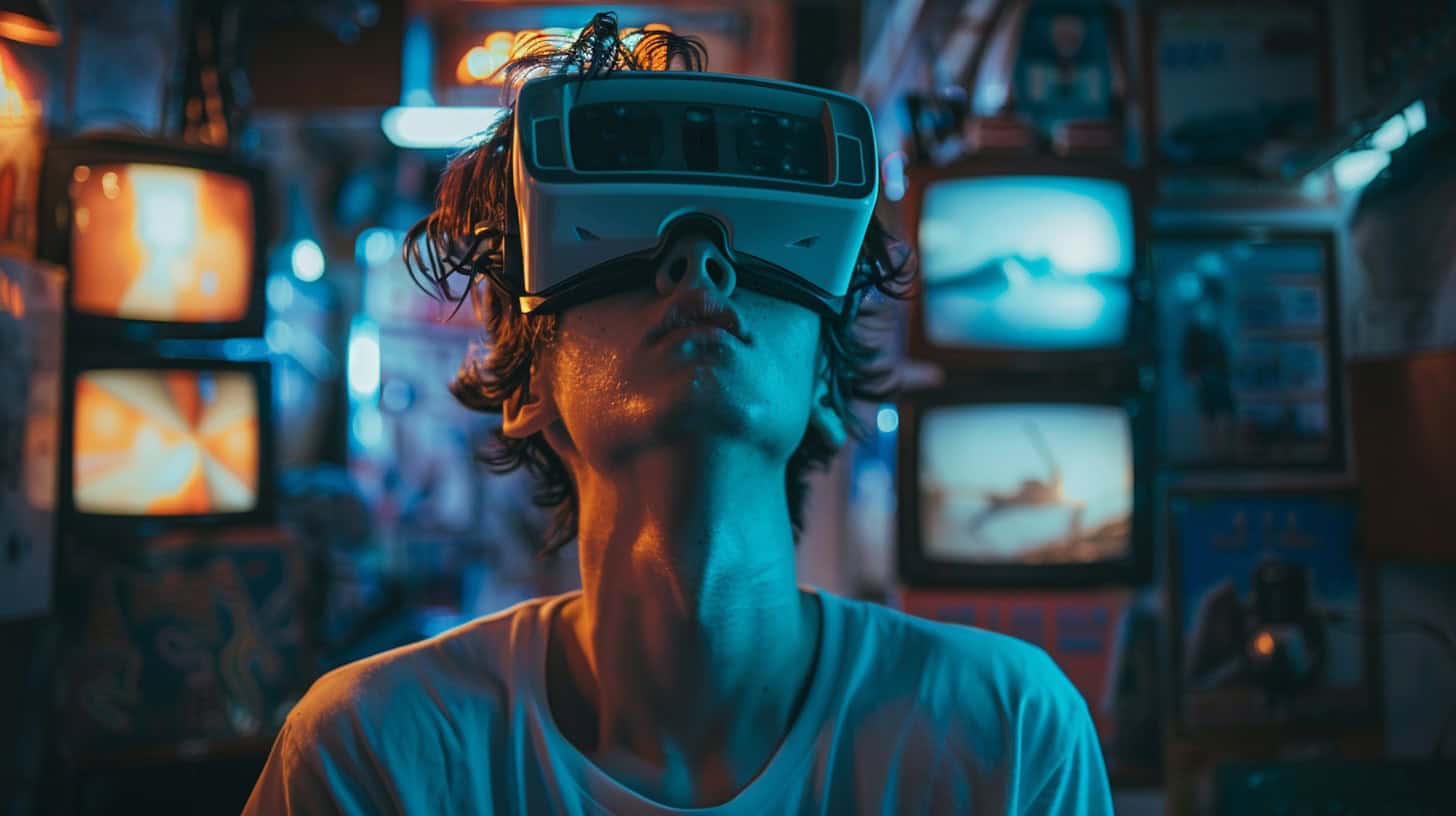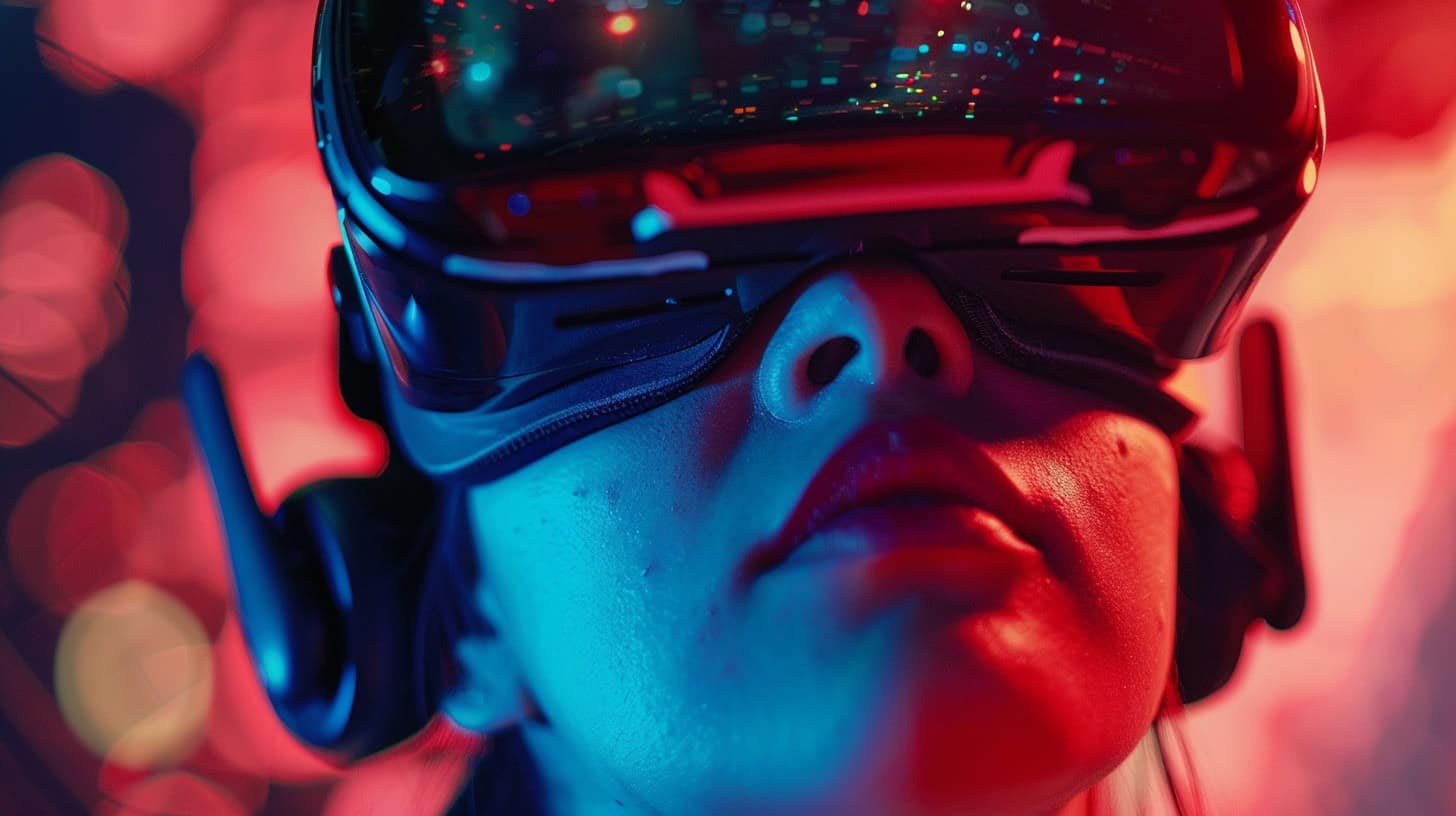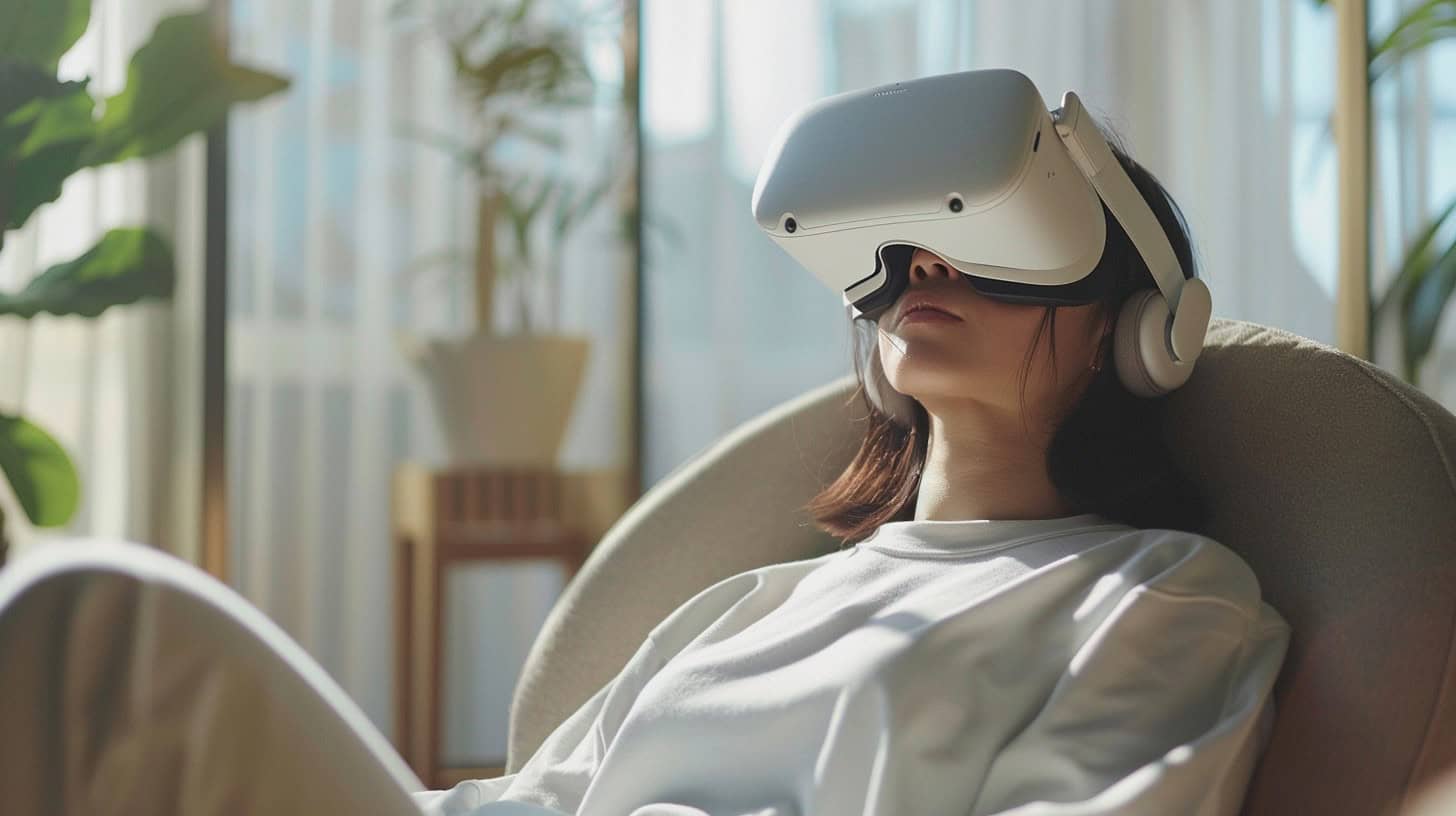Many wonder if virtual reality can harm their eyes. Studies show VR headsets can lead to eye strain and fatigue. Our article offers solutions to reduce discomfort and protect your vision.
Keep reading for insights…
Key Takeaways
VR headsets can cause eye strain, blurry vision, and dry eyes. But taking breaks and adjusting the headset settings helps.
Studies show no long-term damage to eyes from using VR. It’s safe for your eyes with proper use.
The 20-20-20 rule is a good way to prevent eye strain. Look away every 20 minutes at something 20 feet away for 20 seconds.
Eye drops and good room lighting help keep your eyes from getting too dry when using VR.
Changing settings on your VR device, like screen brightness and resolution, makes it easier on your eyes.
Table of Contents
Understanding VR and Eye Health

VR brings cool experiences like playing games or visiting online worlds right to your eyes. With a VR headset, you can immerse yourself in a fully interactive environment, whether you’re exploring fantastical game worlds or engaging in virtual training scenarios. This technology allows users to experience the thrill and excitement of their favorite activities from the comfort of their own home or workplace.
For instance, in professional settings, VR can simulate realistic work environments, helping with training, collaboration, and productivity. However, while VR offers unparalleled convenience and innovation, it’s essential to prioritize your eye health. Extended use of VR headsets can lead to eye strain, fatigue, and other vision-related issues.
If you develop an eye injury related to VR usage from work, you should consider consulting with a Boston personal injury lawyer. A personal injury lawyer can help you understand your rights and guide you through the process of seeking compensation for your injury.
Therefore, it’s important to take regular breaks, adjust your headset settings for optimal comfort, and follow best practices for eye care. By doing so, you can enjoy the innovative and immersive experiences VR has to offer without compromising your vision health.
Potential eye problems from VR headsets
VR headsets can cause some eye problems. Eye strain is common. Users stare at screens close to their eyes for a long time without breaks. This makes the eyes work hard and get tired.
Blurry vision comes next. The virtual reality world might look clear, but once the headset comes off, users might not see as well right away.
Dry eyes happen too. People blink less when they are in a virtual environment because they are focused on what’s happening there. Less blinking means their eyes don’t get enough moisture, which leads to dryness and discomfort.
8% of parents have reported that their children experience eye strain from using VR.
These issues raise concerns about long-term effects on eye health with regular VR use, especially since 1 in every 4,000 users could face seizure symptoms from rapid flashes or intense patterns found in some VR content.
Let’s explore how common these problems are among VR enthusiasts next.
Current research findings
Recent studies show a clear picture. Scientists confirm VR does not damage eyes long-term. This finding comes from analyzing multiple research projects. Let’s break down the details:
| Research Outcome | Details |
|---|---|
| No long-term eye damage | Examination of user experiences over time indicates VR does not cause permanent harm to vision. |
| Positive impact on low vision | Individuals with limited sight have seen improvements in vision when using VR technologies. |
| No developmental issues | Long-term studies reveal no connection between VR headset use and developmental vision problems. |
These findings come from reliable sources. They underline the safety of VR for our eye health. So, yes, VR is safe for your eyes, backed by science. Eye strain and discomfort can happen, just like with any screen time. But, good habits and proper settings can help prevent these minor issues. This evidence gives us confidence in VR’s safety and potential benefits, especially for those with vision challenges.
Common Eye Issues Associated with VR

VR can make your eyes tired and give you blurry sight. It can also dry out your eyes after long use.
Eye strain
Eye strain from virtual reality (VR) headsets happens when your eyes get tired. This usually comes after watching movies in VR or doing things in a virtual world for too long without breaks.
Your eyes work hard to focus on the digital screen close to your face, which is different from looking at real-life objects. The symptoms like headache, blurry vision, and dry eyes tell you it’s time to rest your eyes.
To keep eye strain away, experts suggest taking breaks every 20 minutes by following the 20-20-20 rule: look at something 20 feet away for 20 seconds every 20 minutes of VR use. Also, adjusting the settings on your headset can help a lot.
Make sure the brightness isn’t too high and that everything looks clear so you don’t squint or strain your eyes.
Moving to our next point, let’s talk about how blurry vision fits into this picture.
Blurry vision
VR headsets can lead to blurry vision. This happens because the screens are very close to your eyes, making them work harder than usual. The signs include having a hard time focusing, headaches, feeling dizzy, and even getting sick to your stomach.
It’s like trying to read a book that’s too close to your face for too long.

To fix this problem in VR goggles, try adjusting the settings. Make sure everything is clear and in focus before you start playing. Also, wearing glasses designed for computer screens might help if you usually wear them.
If you keep having problems seeing clearly after using VR or feel any discomfort in your eyes, it might be wise to see an eye care professional right away. They can make sure nothing serious is going on with your sight.
Dry eyes
Using virtual reality headsets can lead to dry eyes. This happens because you blink less when focusing on VR displays. Fewer blinks mean your eyes don’t stay as wet, leading to discomfort.
Dryness isn’t just annoying; it can cause redness and itchiness too.
To keep your eyes comfortable, use eye drops if they feel dry after VR sessions. Make sure the room has good lighting and give your eyes a break every 20 minutes by looking away from the headset.
These steps help prevent dry eyes, ensuring you enjoy VR without discomfort.
Next, we’ll talk about adjusting headset settings for better comfort.
Preventative Measures to Minimize Eye Strain in VR

To keep your eyes healthy while using digital worlds, short breaks are key. Tweaking those VR goggles to fit just right can also cut down on the strain.
Taking regular breaks
Experts say you should step away from VR every 15 minutes. This keeps your eyes healthy. According to the VR experts at Unfinished Man, not taking breaks can lead to eye strain and blurry vision.
To avoid dry eyes and headaches, look away from the screen regularly. Drink water and stretch too. Adjusting your headset for comfort helps as well. It’s all about keeping a balance between fun in virtual worlds and real-world health needs!
Adjusting headset settings
After taking breaks, tweaking your VR headset can further ease eye strain. Many users don’t realize the impact settings have on their experience. For instance, Oculus Quest 2 offers a night mode that cuts down on blue light, known to cause eye fatigue.
Adjusting this setting can make long sessions in digital environments more comfortable.
Also, by optimizing the screen resolution and sharpness, you enhance image quality, which reduces the effort your eyes need to process visuals. High-end devices like Oculus Quest 2 and Valve Index are designed to minimize the “screen door” effect—this means less strain on your eyes from trying to focus through visible pixels.
Make sure you’re using these features; they’re built into premium headsets for a reason.
People Also Ask
Does wearing VR headsets cause eye strain?
Yes, virtual reality technology can lead to digital eye strain. Symptoms include dryness and discomfort in the eyes after long periods of use.
Can VR help with any eye conditions?
Indeed, therapists use virtual reality therapy for conditions like lazy eye and amblyopia. It improves hand-eye coordination and depth perception through immersive video games.
How do I prevent motion sickness in VR?
Adjusting headset settings is key to reducing motion sickness in VR. Ensure proper fit and take regular breaks to minimize symptoms.
Are there special considerations for eyeglass wearers using VR?
Yes, those who wear spectacles should look for head-mounted displays compatible with their frames or consider contact lenses for a better experience.
What fixes exist for discomfort caused by virtual reality?
Taking breaks, adjusting the fit of your device, using eye drops to prevent dryness, and ensuring your prescription is up-to-date can all help alleviate discomfort from extended VR use.
How does virtual reality affect vision over time?
Prolonged exposure to computer-simulated environments may impact visual acuity if not managed properly—regular eye exams ensure that any changes in vision are addressed promptly.



